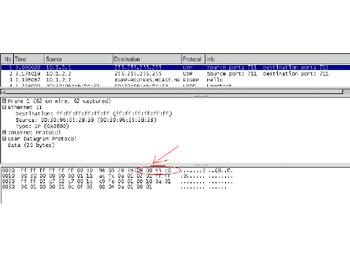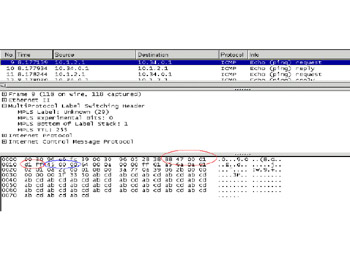Appendix A: Answer Key for Chapter Exercises
|
| < Day Day Up > |
|
Chapter 1 The Fundamentals of MPLS Networks and Data Flow
Exercise 1.1: LER and Granularity
In an MPLS network, the LERs serve as quality of service (QoS) decision points. One method to establish these policies is to use the port numbers in Layer 4 of a packet The tradeoffs in establishing these policies come from how much granularity is needed versus how manageable the configurations and tables are.
In the first example, we have created an MPLS LER table with three criteria: rules on IP address only, IP and protocol number, and IP protocol and port number.
Additionally, we have established routing paths A–Z, and we call them forward equivalence classes, or FECs. The FEC A paths are the highest-quality paths, and the FEC Z paths are the lowest-quality paths.
The policies use the port numbers to place traffic on particular paths. Port numbers are:
20/21 FTP, 25 E-Mail, 80 HTTP, 443 HTTPS, 520 Routing
| 1. | Examine the table and determine the table with the most entries: | |
| 2. | In Table1. 1, using the IP protocol, and port number sections, how would HTTPS be handled in relationship to HTTP? | |
| 3. | Describe a circumstance in which HTTPS should be handled differently from HTTP. | |
| 4. | What FEC classification is given to routing? | |
| 5. | How could giving the previous classification to routing become a problem? | |
Answers
| 1. | The table with the most entries is the table that sorts by IP address, protocol number, and port number. |
| 2. | HTTPS uses FEC A, whereas HTTP uses FEC B. Since HTTPS could produce revenue and is secure it has a higher priority. |
| 3. | HTTPS is given a higher priority because it offers the opportunity for revenue. |
| 4. | Routing is classified as FEC Z (which is the lowest FEC rating). |
| 5. | Routing and label distribution should be given the highest priority in the network; otherwise, packets could be misrouted. |
Exercise 1.2: MPLS Data Flow
We find in an MPLS network that data moves from switch to switch using link-specific labels. Switches perform functions based on their switching or cross-connect tables.
These tables contain information such as port in, label in, port out, label out, next router, and instructions. The instructions are simple: “push” (insert a label), “swap” (change labels), and “pop” (remove label).
In this exercise, sample tracing of a packet through an MPLS network, five routers R1–R5 connect networks X and Z. Tables 1.4–1.8 are used to discover the LSPs. Table 1.4 is used for Router 1, Table 1.5 is used for Router 2, Table 1.6 is used for Router 3, Table 1.7 is used for Router 4, and Table 1.8 is used for Router 5. Each table is different and represents the MPLS routers internal switching table.
In Figure 1.12, we have an example of how data would move in this situation.
In Table 1.4, the packet (being HTTP port 80) enters as native IP/80 where a label (20) is pushed and the packet is sent out of port D. Notice that as the packet traverses the network, it exits Router 1 at port D and enters Router 3 at port B.
In Table 1.6, the label (20) is swapped for label 600, and the packet exits the router at port D, where it is hardwired to port B of R5.
In Table 1.8 (R5), the packet label 600 is popped to deliver a native packet to network Z.
Note that Figure 1.11 reflects the correct labels.
In this exercise, use the switching tables for Routers 1 through 5 and Figures 1.12 and 1.13 to map data flow and labeling across the network. Of course, the tables contain data that is not used for your packet, but they also contain switching data needed for other packets. Use only the data that you need to move your packets. Follow these instructions:
-
Always start with Table 1.4 and follow applications that enter through Interface A.
Table 1.4: Switching Table for Router 1 P_In
Label In
Label Out
Port Out
Instruction
Next Router
IP/80
None
20
D
Push
R3
IP/25
None
95
B
Push
R4
IP/20
None
500
C
Push
R2
-
The decision made by Table 1.4 will lead you to another switching table, depending on the application, port out, and the router out.
-
In Figure 1.12, note that the packet label numbers appear on the drawings. Use Figures 1.13 and 1.14 to indicate the correct label number.

Figure 1.12: Network Trace for HTTP Port Number 80 -
Use Figure 1.13 and Tables 1.4–1.8 to trace e-mail (port 25) through the network, and note the trace on the drawing.
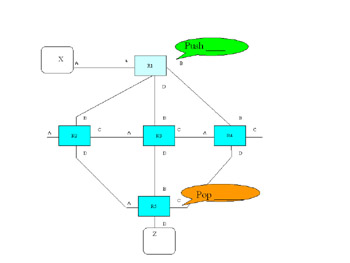
Figure 1.13: Network Trace for Port 25 E-MailTable 1.5: Switching Table for Router 2 P_In
Label In
Label Out
Port Out
Instruction
Next Router
B
499
700
D
Swap
R5
B
500
65
C
Swap
R3
B
501
700
A
Swap
R9
Table 1.6: Switching Table for Router 3 P_In
Label In
Label Out
Port Out
Instruction
Next Router
B
20
600
D
Swap
R5
A
65
650
D
Swap
R5
B
501
700
A
Swap
R9
-
Using Figure 1.14 and Tables 1.4–1.8 to trace FTP (port 20) through the network, and note the trace on the drawing
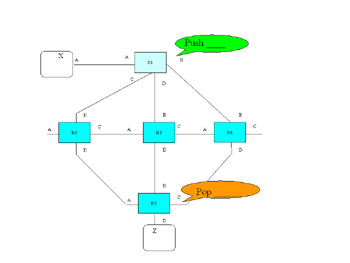
Figure 1.14: Network Trace for Port 20 FTPTable 1.7: Switching Table for Router 4 P_In
Label In
Label Out
Port Out
Instruction
Next Router
B
95
710
D
Push
R5
A
500
650
D
Push
R5
B
515
700
D
Push
R5
Table 1.8: Switching table for Router 5 P_In
Label In
Label Out
Port Out
Instruction
Next Router
A
500
None
D
Pop
CR
B
600
None
D
Pop
CR
B
650
None
D
Pop
CR
C
710
None
D
Pop
CR
Exercise 1.3: Single Stacked Label Decode
There are several ways to complete this lab. The exercise itself is written in standalone form so that you do not need any products to complete the exercises. Just skip the hands-on block that follows.
Hands-On: Compare and Contrast IP/Ethernet and IP/MPLS/Ethernet
In protocol analyzers, we count bytes from left to right and we start counting from 0. So, if the first byte is said to have a value at offset of 0, the second byte is an offset of one.
| 1. | Look at Frame 1 in Figure 1.15. What is the value at offset 12 and 13? | |
| 2. | Look at Frame 1 Figure 1.15. What is the value at offset 14 and 15? | |
| 3. | Look at Frame 9 in Figure 1.16. What is the value at offset 12 and 13? Why is this value different? What does it mean? | |
| 4. | Look at Frame 9 in Figure 1.16. What is the value at offset 14, 15, 16, 17? Translate the hex number into binary using the following chart. 128 64 32 16 8 4 2 1. 128 64 32 16 8 4 2 1. 128 64 32 16 8 4 2 1. 128 64 32 16 8 4 2 1 | |
| 5. | Determine the values for the following.
| |
| 6. | Look at offsets 18 and 19. What are their values? | |
| 7. | Compare the values in questions 5 and 2 above. What do you find interesting about them? | |
Answers
| 1. | The value at offset 12 and 13 is 0800 (the next header is IP). | ||||||||
| 2. | 45 CO (IP Version 4 with a 20 byte header and class of service) | ||||||||
| 3. | 8847 (A shim header next). In Figure 1.15 frame 1, the note indicates that an IP header is next. In Figure 1.16, the note indicates that a shim header MPLS is next. It means that the frame has been modified to accommodate MPLS. | ||||||||
| 4. | 00 1 1 f Translate the hex number into binary using the chart below.
| ||||||||
| 5. |
| ||||||||
| 6. | 45 00 | ||||||||
| 7. | MPLS was inserted and moved the start of the IP header by 32 bits. |
Exercise 1.4: Stacked Decode
In this exercise, you will decode and study an MPLS packet used in a tunneling situation where labels are stacked.
There are several ways to complete this exercise. The exercise itself is written in standalone form so that you do not need any products to complete the exercises.
Hands-On: Open the File and Review File Content Review File Content
If you are the “hands-on” type and you want to see MPLS packets on a protocol analyzer, you need the two items of software (Ethereal and the MPLS-basic-cap sample) mentioned in the previous hands-on exercise.
-
From your desktop, go to Start | Programs and click Ethereal.
-
Once Ethereal opens, open the file called MPLS1.cap.
-
Wait for the file to open. It will take a few minutes.
The file should look like Figure 1.17. Now let’s review the file content in the following steps.
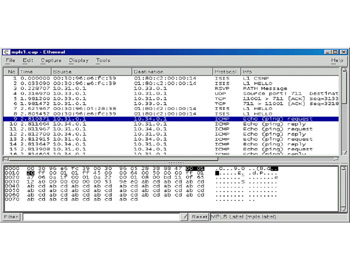
Figure 1.17: Open MPLS_basic File
| 1. | Look at Frame 9, as shown in Figure 1.17. Note the values found at offsets 14 to 21. Record them in hex here: _____ _____ _____ _____ _____ _____ _____ _____ 14 15 16 17 18 19 20 21 | |
| 2. | Using the following chart, translate the hex number into binary for Label 1 found at offsets 14-17. 128 64 32 16 8 4 2 1. 128 64 32 16 8 4 2 1. 128 64 32 16 8 4 2 1. 128 64 32 16 8 4 2 1 | |
| 3. | What are the values for each of the following for Label 1??
| |
| 4. | Using the following chart, translate the hex number into binary for Label 2 found at offsets 18-21. | |
| 5. | What are the values for each of the following for Label 2?
| |
| 6. | Is the stack bit set for Label 1 (offset 14-17)? | |
| 7. | Is the stack bit set for Label 2 (offset 18-21)? | |
| 8. | Explain why the stack bit may be set differently. | |
Answers
| 1. | 00 01 20 ff 00 01 01 ff 14 15 16 17 18 19 20 21 | ||||
| 2. |
| ||||
| 3. |
| ||||
| 4. |
| ||||
| 5. |
| ||||
| 6. | OFF | ||||
| 7. | ON | ||||
| 8. | The stack bit is turned on to indicate that this is the last header in the stack (or the header closest to the IP header). |
|
| < Day Day Up > |
|
EAN: 2147483647
Pages: 138
